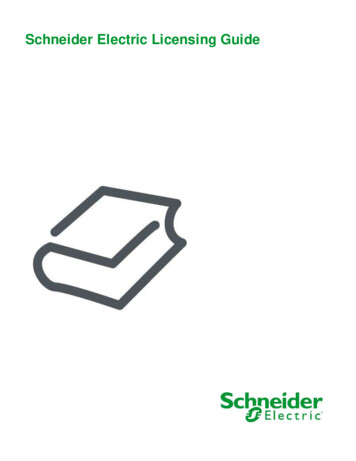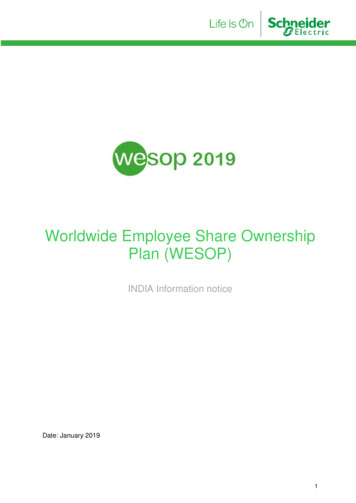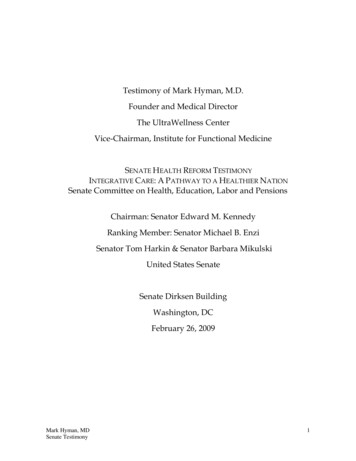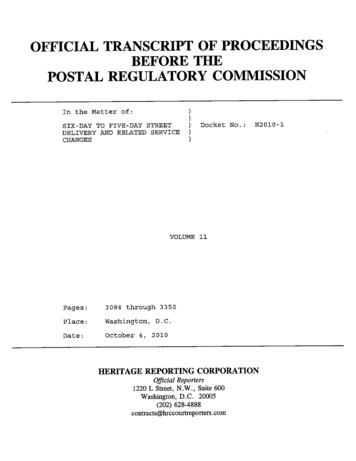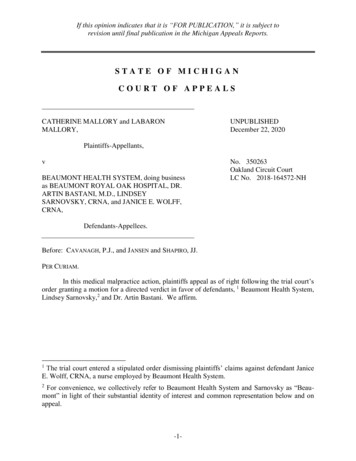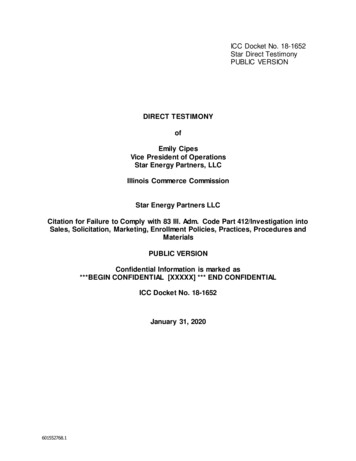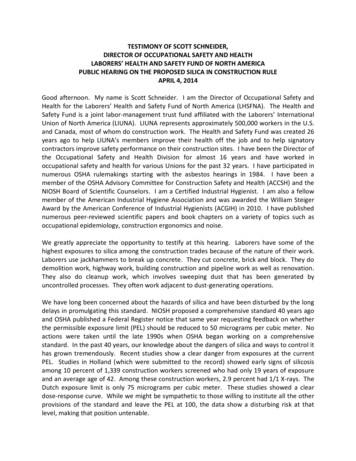
Transcription
TESTIMONY OF SCOTT SCHNEIDER,DIRECTOR OF OCCUPATIONAL SAFETY AND HEALTHLABORERS’ HEALTH AND SAFETY FUND OF NORTH AMERICAPUBLIC HEARING ON THE PROPOSED SILICA IN CONSTRUCTION RULEAPRIL 4, 2014Good afternoon. My name is Scott Schneider. I am the Director of Occupational Safety andHealth for the Laborers’ Health and Safety Fund of North America (LHSFNA). The Health andSafety Fund is a joint labor-management trust fund affiliated with the Laborers’ InternationalUnion of North America (LIUNA). LIUNA represents approximately 500,000 workers in the U.S.and Canada, most of whom do construction work. The Health and Safety Fund was created 26years ago to help LIUNA’s members improve their health off the job and to help signatorycontractors improve safety performance on their construction sites. I have been the Director ofthe Occupational Safety and Health Division for almost 16 years and have worked inoccupational safety and health for various Unions for the past 32 years. I have participated innumerous OSHA rulemakings starting with the asbestos hearings in 1984. I have been amember of the OSHA Advisory Committee for Construction Safety and Health (ACCSH) and theNIOSH Board of Scientific Counselors. I am a Certified Industrial Hygienist. I am also a fellowmember of the American Industrial Hygiene Association and was awarded the William SteigerAward by the American Conference of Industrial Hygienists (ACGIH) in 2010. I have publishednumerous peer-reviewed scientific papers and book chapters on a variety of topics such asoccupational epidemiology, construction ergonomics and noise.We greatly appreciate the opportunity to testify at this hearing. Laborers have some of thehighest exposures to silica among the construction trades because of the nature of their work.Laborers use jackhammers to break up concrete. They cut concrete, brick and block. They dodemolition work, highway work, building construction and pipeline work as well as renovation.They also do cleanup work, which involves sweeping dust that has been generated byuncontrolled processes. They often work adjacent to dust-generating operations.We have long been concerned about the hazards of silica and have been disturbed by the longdelays in promulgating this standard. NIOSH proposed a comprehensive standard 40 years agoand OSHA published a Federal Register notice that same year requesting feedback on whetherthe permissible exposure limit (PEL) should be reduced to 50 micrograms per cubic meter. Noactions were taken until the late 1990s when OSHA began working on a comprehensivestandard. In the past 40 years, our knowledge about the dangers of silica and ways to control ithas grown tremendously. Recent studies show a clear danger from exposures at the currentPEL. Studies in Holland (which were submitted to the record) showed early signs of silicosisamong 10 percent of 1,339 construction workers screened who had only 19 years of exposureand an average age of 42. Among these construction workers, 2.9 percent had 1/1 X-rays. TheDutch exposure limit is only 75 micrograms per cubic meter. These studies showed a cleardose-response curve. While we might be sympathetic to those willing to institute all the otherprovisions of the standard and leave the PEL at 100, the data show a disturbing risk at thatlevel, making that position untenable.
This isn’t some theoretical or hypothetical problem; it is a very real one. Despite all the claimsthat silicosis is disappearing in this country, the only reason that appears to be the case is thatwe haven’t looked for it. We have no real surveillance system in this country for occupationallung disease. Construction workers who change jobs frequently certainly are not beingscreened for it. I was disturbed to hear at these hearings last week that a company whichseemed to be doing all it could to protect its workers, including giving them medical exams,failed to give them chest X-rays as part of those exams. A few years from now, should workersfrom that company discover they have silicosis, they are going to wonder why it was notidentified earlier. I suspect there might be some liability at that point, as well as some regret.The employer associations who have testified at this hearing who are convinced that silicosis isa thing of the past have been deceived by the silicosis mortality data. They haven’t looked at allof the data, which tells a very different story. This is before we even go into the evidence onlung cancer, renal disease, etc.Likewise, they have been convinced that a 25 microgram action level is unmeasurable. Yet foryears, the ACGIH has had a 25 microgram limit as have some jurisdictions (e.g., Alberta) The 50microgram standard is easily measured using current 1.7 liter pumps. 4.2 liter pumps arewidely available. They draw over twice as much air per minute and consequently can easilymeasure half the 50 microgram level. It is simple math.Industry claims the standard is economically infeasible, but the benefits vastly outweigh thecosts even if OSHA’s estimates are low. The arguments made by industry to try and inflate thecosts have been almost laughable. To suggest that OSHA has to consider the costs incurred by2.5 million self-employed workers in construction just doesn’t hold water. Just about everyOSHA standard which has had a “look back” has shown the costs to be greatly overestimated asindustry has innovated to meet the new standard. These claims should probably be consideredjust that – claims, with little to support them.So the issue boils down to technological feasibility. We have reviewed the data in the recordcarefully. From our reading, we are convinced that most operations can meet the 50microgram standard most of the time. This is particularly true as many of these tasks are notperformed for a full day. OSHA acknowledged that in Table 1 by allowing for the use of controlswithout respiratory protection for many operations of four hours or less. We believe a newOSHA standard with a lowered PEL will spur innovation in the construction industry to meet thechallenge. We have already seen how industry can partner with labor and manufacturers toreduce exposures successfully in NAPA’s testimony on the asphalt milling partnership. Couldother sectors duplicate this effort? Absolutely. Every month, we see trade magazines toutingnew tools with dust-collecting equipment to “help employers comply with a proposed OSHArule.” This will only increase. With a lax standard and little enforcement, many uncontrolledoperations are exposing thousands of construction workers every day to dangerous clouds ofsilica. This standard will help shift the industry to controlling exposures as the norm andsimultaneously change the culture from a lack of regard for worker health to concern and
attention to it. Right now, workers are suffering the impact of this neglect. By changing theculture through a new standard, we can preserve worker health, help construction workers leadlonger and healthier lives and, based on much of the testimony to date, likely make work moreproductive in the process.We fully support this effort. We also support the comments from the Building and ConstructionTrades Department and the AFL-CIO, both of which we worked closely with in developing theircomments.We would also like to echo the comments of the International Union of Operating Engineersabout the need to reconsider how demolition work is approached and how it might be coveredin Table 1. Demolition by its nature involves the crushing of construction materials whichcontain silica. Operators can be, and should be, protected in air-conditioned cabs with filteredair. Laborers who assist operators on the ground may have higher exposures. In addition,LIUNA’s members are involved in shotcreting and guniting operations where concrete isbasically sprayed onto surfaces. These operations are generally done in closed or confinedspaces so, even though these are wet operations, there is the potential for high exposures.These operations need to be reviewed by OSHA before the final rule is promulgated.Now I would like to introduce the rest of our panel who will address specific elements of theproposal.Walter Jones from the LHSFNA will discuss control technology.Travis Parsons from the LHSFNA will discuss competent person requirements.Dr. Jim Melius from the NYS Laborers’ Health and Safety Fund and the LHSFNA will discuss themedical surveillance requirements.Eddie Mallon, Laborers’ Local 147, New York City, will discuss his experiences as a sandhog.Ken Hoffner from the New Jersey Laborers’ Health and Safety Fund will discuss the work of theSilica Partnership in New Jersey.Tom Nunziata from the LIUNA Training and Education Fund will discuss the trainingrequirements.
TESTIMONY OF WALTER JONES,ASSOCIATE DIRECTOR OF OCCUPATIONAL SAFETY AND HEALTHLABORERS’ HEALTH AND SAFETY FUND OF NORTH AMERICAPUBLIC HEARING ON THE PROPOSED SILICA IN CONSTRUCTION RULEAPRIL 4, 2014Hi, my name is Walter Jones and I am the Associate Director of the Occupational Safety andHealth Division of the Laborers' Health and Safety Fund of North America (LHSFNA) and aCertified Industrial Hygienist. For six plus years, spanning two administrations, I have served asan employee representative on OSHA’s Advisory Committee on Construction Safety and Health(ACCSH). I have co-chaired ACCSH’s Silica Workgroup with Matt Gillen, NIOSH and variousACCSH employer representatives. Most of our early work focused on the development of atasked-based approach to controlling exposure to silica and the use of objective data as asubstitute for sampling. Our Workgroup meetings were heavily attended by constructionindustry stakeholders, many of whom are in this room today. Although the rules did not requireit, the Workgroup not only reached a consensus among ACCSH members, but also sought outthe “sense of the room” – non-binding votes of all in attendance before we advanced any topic.It was clear to all ACCSH stakeholders that the current IH exposure assessment model was notan efficient method for controlling construction exposures. ACCSH members and otherconstruction industry stakeholders all agreed that it would be more effective and efficient to tiesilica control to worker tasks and activities. The 2003 OSHA Small Business RegulatoryEnforcement Fairness Act (SBREFA), Georgia Tech OSHA Consultation Program, ASTM SilicaStandard and silica control matrix supplied by the LHSFNA all led the ACCSH to recommend thatOSHA include a similar compliance alternative for construction in the proposed rule.At the December 2009 ACCSH meeting, an OSHA Directorate of Standards and Guidance (DSG)panel (Director Dorothy Dougherty, Deputy Director Bill Perry and David O’Connor) provided aPowerPoint presentation describing OSHA’s most current thinking on the requirementscurrently under consideration for the proposed silica standard, with an emphasis on areas ofchange from the version previously prepared for the SBREFA review. After the presentation, Imoved for (1) the ACCSH to support an expanded concept of Table 1 in the 2003 SBREFA draft;(2) the inclusion of a competent person requirement into the proposal; and (3) the exemptionof employers from monitoring requirements if they implement specific controls from Table 1.All passed unanimously.As we look out across the country, we see that states and municipalities are passing laws toprotect their citizens and workers from silica containing dust. The states of California and NewJersey and the cities of Boston and Chicago prohibit dry cutting/pulverizing without ventilationor wet methods and respirators. Many more require the control of all fugitive dusts.On a project at the Harvard Fogg Museum in Boston where we looked at silica controls andsmoking cessation efforts, the workers reported that dust control use was based on whetherthe project was within the city limits. At the CPWR Silica Control Workgroup meeting inChicago, researchers documented the unusual prevalence of dust control use in the city of
Chicago. Recently, I toured the Bay Bridge demolition project in San Francisco where it isrequired that all forms of dust be captured, controlled and not allowed to fall into the Bay,neighboring properties or onto the ground below the bridge. I also recently toured the new49ers stadium project in Santa Clara. On that project, subcontractors reported that dust controlefforts, whether environmental or occupational, are commonplace and were treated equally.Dust control on construction projects is already an important responsibility of contractors andnot a new concept. As matter of fact, we can only expect efforts to intensify in the future.Therefore, it is time to even the playing field and hold all parties to the same standard –whether we are talking about non-compliant contractors, rural communities or workers’ health.Many localities have rejected the idea that contractors are not responsible for the dust plumescreated during construction activities. Contractors are not allowed to let dust plumes blow intoneighboring yards, streams or sewers. I cannot impress upon you the concern expressed bysignatory contractors and affiliates throughout the years because silica dust plumes have raineddown on cars or the fear expressed when it was realized that pedestrians may have to walkthrough such plumes. Whenever I have helped on a project to abate these environmentalconcerns, worker exposures were never brought up. It was up to me to make the case forcontrolling dust at the source through ventilation and water instead of opting to the defaultposition of enclosure. How many times do we see that the response to these environmentalconcerns is to button up the project into a plastic balloon to protect nearby cars andpedestrians? Often, this only increases worker exposures.The beauty of Table 1 is in its ability to be both pragmatic and forward-leaning. Occupationaldust control is as much an art as it is science. For example, exposures can easily go fromcompliant to hazardous based solely on the operator, contractor, experience or maintenancelevel of equipment. It is vitally important that OSHA not only automatically require controlactivities for every task and tool, but also enforce the notes section of Table 1 to preventuneven application of compliance activities that may easily turn hazardous. Table 1 not onlymakes compliance easier to determine, enforce and teach, but it also assures an acceptablelevel of healthfulness. At its core, the proposal is a technology -forcing standard without whichwe would be stuck listening to the flat-earthers tell us that the hierarchy of controls is outdatedand the future of worker health is with respirators. To them I say," I got a bridge in Brooklyn forsale."Our brothers and sisters on the environmental side do not have to deal with such lack ofconcern about a problem. Environmentalists did not have to ask Americans to wear respiratorsbecause it was infeasible for industry to remove lead from gasoline and because it would costAmerica jobs. Instead, they fought to have lead removed from gasoline, which became one ofthe greatest public health successes of our lifetime. Around the globe, other rich industrializedcountries chose to side with the infeasibility argument, which forces their citizens to walkaround with respirators through murky clouds of dust, particulate matter and pollution.OSHA’s forward-leaning proposal will create an environment wherein equipmentmanufacturers can aggressively develop and promote existing new control technology. As Ken
mentioned, we have worked to develop a jackhammer dust control protocol and in spite ofwhat I testified to today, the equipment manufactures tell us that there is no market for it.There has always seemed to be a tacit compact between equipment manufacturers and for thatmatter the entire construction industry, of not using “worker health and safety” to acompetitive advantage. I’m often told by equipment manufacturers that the demand does notexist for safer equipment or that they do not want to assume some perceived “liability” ifabatement does not work as advertised; to which I reply that those same manufacturers havenever been to a health food store where every product promises strength, vitality and long life.Imagine that. Earlier this week, the MCAA reported here that diamond blade saw suppliers aredeclaring that that water used to keep their products maintained has nothing to do with dustcontrol. They are afraid to even acknowledge the positive ancillary worker health benefitsassociated with the proper use of the equipment. Equipment manufactures seem fearful ofbreaking the silent compact on worker safety and willing to continue to wait on the sidelines forOSHA to require their participation. When equipment manufacturers do start fully participating,it will be for OSHA compliance purposes only. That is why it is imperative that OSHA moveforward with the standard. I am convinced that the dust capture and control market will takeoff with a little prodding. Can you imagine if the free market just applied 10 percent of thetechnology used in my phone to dust control to make products more responsive,companionable and comfortable? Greater production, use and protection would be ensured.
TESTIMONY OF TRAVIS PARSONS,SENIOR SAFETY & HEALTH SPECIALISTLABORERS’ HEALTH AND SAFETY FUND OF NORTH AMERICAPUBLIC HEARING ON THE PROPOSED SILICA IN CONSTRUCTION RULEAPRIL 4, 2014IntroductionHello, I am Travis Parsons, the Senior Safety & Health Specialist at the Laborers’ Health & SafetyFund of North America (LHSFNA). I have worked as a safety and health professional at theLHSFNA for 12 years. I provide an array of safety and health services to the members andsignatory contractors of the Laborers’ International Union of North America (LIUNA) on issuesconcerning workplace safety and health on a multitude of worksites throughout the UnitedStates and Canada. I would first like to thank OSHA for the opportunity to testify today andcommend the Agency on moving forward on a very important standard for LIUNA’s membersand the construction industry. I have participated in OSHA’s rulemakings on Chromium (VI),Cranes and Derricks in Construction and Confined Spaces in Construction. I am also an OSHAMaster Instructor for OSHA 500/502 courses in the construction industry. I have been on manyworksites and seen first-hand that many construction workers are repeatedly exposed toexcessive amounts of toxic silica dust, which is a known human carcinogen. In a statement tothe Center for Public Integrity, OSHA itself called silica one of the most pervasive hazards foundin the workplace. In my testimony, I am going to focus on question #35 from OSHA’s identifiedissues with the proposed rule:Competent person: OSHA has proposed limited duties for a competent person relating toestablishment of an access control plan. The Agency did not propose specific requirements fortraining of a competent person. Is this approach appropriate? Should OSHA include acompetent person provision? If so, should the Agency add to, modify or delete any of the dutiesof a competent person as described in the proposed standard? Provide the basis for yourrecommendations.Competent PersonsTo me, including competent person provisions in the new rule are a no brainer. Almost everyorganization that I have heard testify over the past three weeks has mentioned somethingabout the variability in the construction industry and the transient nature of the workforce. Thisalone exemplifies the need for stronger competent person requirements in a silica standard forthe construction industry. OSHA defines a competent person as "one who is capable ofidentifying existing and predictable hazards in the surroundings or working conditions which areunsanitary, hazardous or dangerous to employees, and who has authorization to take promptcorrective measures to eliminate them" [29 CFR 1926.32(f)]. By way of training and/orexperience, a competent person is knowledgeable of applicable standards, is capable ofidentifying workplace hazards relating to the specific operation and has the authority to correctthem. Some standards add additional requirements which must be met by the competent
person. When it comes to silica, a competent person is needed to ensure that controls areworking properly to protect workers. Competent person requirements are especially useful forhealth standards because of the unique training and knowledge a person will need to be asuitable competent person. Furthermore, if contractors rely on Table 1 for compliance, theremay be a need for respirators as a last means of defense. This is another reason to have acapable competent person on site that can make the appropriate decisions to protect theirfellow workers. A competent person is also a powerful tool to reduce exposures inenvironments that are especially hazardous, such as in abrasive blasting and regulated areas.A 2013 white paper published by the American Industrial Hygiene Association (AIHA), titledRecommended Skills and Capabilities for Silica Competent Persons, states that a key componentin preventing overexposure to silica and subsequent disease is to have at least one individualon the worksite who is capable of recognizing and evaluating situations where overexposuremay be occurring, who knows how to evaluate the exposure potential and who can make aninitial recommendation on how to control that exposure. This is a competent person. In a 2009meeting, OSHA’s own Advisory Committee for Construction Safety and Health (ACCSH)recommended that OSHA utilize a competent person approach for silica. Competent personprovisions were also in the original 2003 proposed standard and should be included in the finalrule.SummaryAs I previously mentioned, construction work is fluid, it changes on a daily basis and fromworksite to worksite. Numerous OSHA regulations (19) account for this by investing power andauthority in a competent person and the silica standard for construction should be no different.The use of a competent person has been a longstanding staple of safety and healthconstruction standards, and is commonly used by conscientious contractors, OSHA and theAmerican National Standards Institute (ANSI) for construction regulations and best practices.Competent persons can ensure controls are being used effectively and know when to call in aqualified person (e.g., an industrial hygienist) for more complex or unusual scenarios. The useof a competent person is also a way to ensure that workers with potential exposures to silicadust are trained to protect themselves. As the silica proposal rightly places a heavy emphasison the proper use of controls, and exposures can vary greatly if controls are not used properly,a competent person is essential to ensure these controls are used properly. The competentperson can monitor water flow rates, the functionality of local exhaust ventilation and othercontrols used. We recommend that OSHA include and strengthen the competent personprovisions in the final rule. We believe the competent person is one of OSHA’s most vital andeffective safety and health tools in the construction industry and must be a part of the newrule.
TESTIMONY OF JAMES MELIUS, MD, DrPH,ADMINISTRATORNEW YORK STATE LABORERS HEALTH AND SAFETY TRUST FUNDPUBLIC HEARING ON THE PROPOSED SILICA IN CONSTRUCTION RULEAPRIL 4, 2014As mentioned in previous comments, our Union members are exposed to silica in a variety oftypes of construction work, and, as a result of this exposure, they have an increased risk ofdeveloping silicosis and other illnesses.The proposed OSHA silica standard includes provisions for medical surveillance. Given the riskof serious lung disease and cancer among silica-exposed workers, medical surveillance is animportant element of the proposed standard. This is a major improvement over the currentsituation and will benefit many of our members who are at risk of respiratory disease becauseof their silica exposure. Although we support the major elements of the medical surveillanceprovisions in the proposed standard, there are a number of issues with the proposed medicalsurveillance provisions that need to be addressed:1. Trigger – Given the structure of the proposed construction standard, utilizing theproposed PEL to trigger medical surveillance is the most practical approach. However,given the widespread nature of silica exposures in the construction industry, thefrequent employer and job rotation and the difficulty of documenting individual silicaexposures in construction, a 30 day requirement (above the PEL) will be difficult toadminister in construction. We suggest either eliminating this requirement forconstruction workers or providing clear guidance on the 30 day requirement, including apresumption that 30 days of work in tasks that could lead to substantial exposures tosilica is sufficient to trigger the medical surveillance or some alternative approach. Inaddition, the standard needs to account for the cumulative effects of silica exposure andthe delayed onset of many manifestations of silica exposure.2. Frequency of exams – We support the provisions requiring an initial exam within 30days and then once every three years. However, in certain circumstances, theexamination should be more frequent, including when recommended by the examininghealth care provider, when the employee has abnormal pulmonary function testing orwhen the employee’s reports indicate he or she may have a silica-related illness. Ifignored and permitted to follow the proposed three year schedule, the employee with amore rapid clinical course for their silicosis may be at risk for not having their illnessdetected in a timely fashion.Construction workers frequently change employers and may have multiple employerswithin a single year. In order to avoid unnecessary examinations, the standard shouldinclude provisions that encourage arrangements where contractors could poolresources to provide examinations for a group of workers who may rotate among theseemployers. Such programs have been successfully implemented by union contractor
associations for respirator fitness, drug testing and other required medical examinationsand would also be useful and cost effective for silica surveillance. At the same time,they would eliminate unnecessary X-rays and other examinations for silica-exposedconstruction workers.3. Content of examinations – We support the proposed content of the medicalsurveillance examinations. However, there needs to be clear provisions for ensuringthat the pulmonary function testing is done properly in order to appropriately detectchanges over time. The spirometry should be required to meet American ThoracicSociety or similar guidelines, and there should be guidelines for evaluating changes in anindividual’s pulmonary function over time.Silica-exposed workers are also at risk of developing lung cancer. There is now goodscientific evidence supporting the use of low-dose CT scans for the early detection oflung cancer. This should be added as a required part of the silica medical surveillance.The U.S. Preventive Services Task Force has recently made a recommendation for thisscreening in the general population. Although their guidelines do not include detailedrecommendations on occupational lung cancer risk, the basic justification for thisscreening would also apply to occupational exposures. As the specific guidelines for thistesting are still being developed, the standard should provide for the adoption of newerguidelines as they become available.4. Confidentiality – The confidentiality provisions of the proposed standard are inadequateand would place our members at significant risk of being discriminated against in hiringand job retention. We also see a growing trend of our members being denied workbased on poorly justified fitness guidelines which have no basis in sound medicalscience. The current provisions of this standard would only aggravate this situation byproviding personal medical information to the employer, which some employers mightuse as a rationale for not hiring a worker or not retaining their current employment.We believe that all individual medical information should only be shared with theemployee being examined (similar to the provisions in the Black lung rules). Theexamining physician should only provide the employer with information as to theemployee’s ability to wear a respirator. The standard must also include languageprohibiting any retaliation against the employee based on the results of the medicalprogram, their participation in the program or their decision on what personal medicalinformation (if any) to share with the employer.
TESTIMONY OF JAMES MELIUS, MD, DrPH,ADMINISTRATORNEW YORK STATE LABORERS HEALTH AND SAFETY TRUST FUNDPUBLIC HEARING ON THE PROPOSED SILICA IN CONSTRUCTION RULEAPRIL 4, 2014Tunnel Construction:As mentioned in previous comments, our union members are exposed to silica in various typesof construction work. These include asphalt pavement milling where I would like to indicatethat we also endorse the recommendations from NAPA regarding protection for people doingthis type of work.Some of the potential for our most severe exposures are in tunnel work where the confinednature of the work, the often limited ventilation and the ability of tunnel boring machines andother tunnel equipment to generate dust from excavating large amounts of material can lead tosubstantial silica exposures for our members. The varying silica content of the ground beingtunneled can cause substantial changes in silica exposures as the tunnel boring progresses.Many members of our local union in New York City that performs only tunnel work havedeveloped silicosis and have received compensation for this work-related illness. A recentsmall medical screening of thirteen members of this union (median job duration: eight years)foun
The 2003 OSHA Small Business Regulatory Enforcement Fairness Act SBREFA), Georgia Tech OSHA Consultation Program, ASTM Silica (Standard and silica control matrix supplied by the LHSFNA all led the ACCSH to recommend that OSHA include a similar compliance alternative for construction in the proposed rule.
